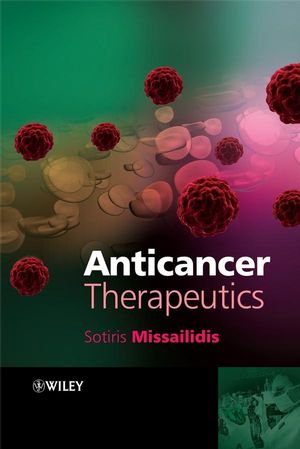Anticancer TherapeuticsISBN: 978-0-470-72303-6
Hardcover
424 pages
December 2008
 This is a Print-on-Demand title. It will be printed specifically to fill your order. Please allow an additional 10-15 days delivery time. The book is not returnable.
|
||||||
Preface.
SECTION I: DEVELOPMENT OF ANTICANCER THERAPEUTICS.
1. Exploring the potential of natural products in cancer treatment (Fotini N. Lamari and Paul Cordopatis).
1.1 Introduction.
1.2 Sources.
1.3 Different approaches to the search for bioactive natural products.
1.4 Methodologies of lead compound or new drug identification.
1.5 Chemoprevention - a new area for natural product research.
1.6 Concluding remarks.
2. Combinatorial approach to anticancer drug design (Sotiris Missailidis).
2.1 Introduction.
2.2 Combinatorial approaches for small molecule drug design.
2.3 Display technologies.
2.4 Aptamer selection.
2.5 Conclusions.
3. Rational approaches to anticancer drug design/in silico drug development (Stefano Alcaro, Anna Artese and Francesco Ortuso).
3.1 Introduction.
3.2 Approaches to the drug discovery process in anticancer research.
3.3 Ligand-based examples.
3.4 Structure-based examples .
3.5 Conclusions.
SECTION II: ANTICANCER THERAPEUTICS.
4. Introduction (Teni Boulikas).
4.1 Introduction.
4.2 Problems in cancer .
4.3 Cancer treatments .
4.4 Classification of chemotherapy drugs .
5. Platinum drugs (Teni Boulikas, Alexandros Pantos, Evagelos Bellis and Petros Christofis).
5.1 Cisplatin.
5.2 Lipoplatin.
5.3 Carboplatin.
5.4 Oxaliplatin.
5.5 Lipoxal.
5.6 New platinum compounds.
5.7 Cisplatin resistance and chemotherapy.
6. Antimicrotubule agents (Iain Brown, Jay N Sangrithi-Wallace and Andrew C Schofield).
6.1 Taxanes.
6.2 Vinca alkaloids.
6.3 Conclusions.
7. Antimetabolites in cancer therapy (Jessica Scaiffe and David Kerr).
7.1 Introduction.
7.2 Folate antagonists.
7.3 Pyrimidine antagonists.
7.4 Purine antagonists.
7.5 Summary.
8. Antitumour antibiotics (Manuel M. Paz).
8.1 Introduction.
8.2 Actinomycin .
8.3 Mitomycin C.
8.4 Bleomycin.
8.5 Anthracyclines .
8.6 Trabectedin (ecteinascidin, ET-743).
8.7. Camptothecins.
8.8 Podophyllotoxins .
9. Alkylating agents (Ana Paula Francisco, Maria de Jesus Perry, Eduarda Mendes and Rui Moreira).
9.1 Introduction.
9.2 Nitrogen mustards.
9.3 Methylmelamines and ethylenimines.
9.4 Methylhydrazine derivatives.
9.5 Alkylsulfonates.
9.6 Nitrosoureas.
9.7 Triazenes.
10. Hormone therapies (George C. Zografos, Nikolaos V. Michalopoulos and Flora Zagouri).
10.1 Introduction.
10.2 Oestrogen receptor targeted therapeutics.
10.3 Progesterone targeted therapy.
10.4 Neuroendocrine tumours .
11. Photodynamic therapy of cancer (K. Eszter Borbas and Dorothée Lahaye).
11.1 Introduction.
11.2 Photosensitizers.
11.3 Outlook.
11.4 Acknowledgement.
12. Target-directed drug discovery (Tracey Bradshaw).
12.1 Introduction .
12.2 Tyrosine kinases - role and significance in cancer.
12.3 Targeted therapy for the treatment of non-small cell lung cancer.
12.4 Targeted therapy for the treatment of chronic myeloid leukaemia.
12.5 Targeted therapy for the treatment of breast cancer.
12.6 Angiogenesis.
12.7 Targeting cell cycling.
12.8 Targeting apoptosis.
12.9 Targeting mTOR.
12.10 The future of molecularly targeted therapy.
13. Tumour hypoxia: a malignant mediator (Jill L. O’Donnell, Aoife M. Shannon, David Bouchier-Hayes).
13.1 Introduction.
13.2 Hypoxia inducible factor-1 and hypoxia.
13.3 HIF-1? post-translational changes.
13.4 How genetics can modify HIF.
13.5 How tumours overcome hypoxia with HIF-1.
13.6 HIF-1 therapeutics.
13.7 Conclusion.
14. Resistance to chemotherapy drugs (Robert O?Connor and Laura Breen).
14.1 Introduction.
14.2 What are the factors limiting the efficacy of cancer chemotherapy treatment?.
14.3 A classification of the important chemotherapy resistance mechanisms.
14.4 Illustrative mechanisms of pharmacokinetic resistance .
14.5 Illustrative mechanisms of pharmacodynamic resistance.
14.6 Conclusion.
15. Cancer immunotherapy (Maria Belimezi).
15.1 The molecular basis of cancer immunotherapy and gene immunotherapy of cancer.
15.2 Recombinant monoclonal antibodies.
15.3 Gene immunotherapy.
15.4 Cancer vaccines.
15.5. Adoptive cellular therapy.
16. Gene therapy (Maria Belimezi, Teni Boulikas and Michael L. Roberts).
16.1 The concept of gene therapy.
16.2 Steps for successful gene therapy.
16.3 Retroviruses in cancer gene therapy.
16.4 Adenoviruses in cancer gene therapy .
16.5 Gene therapy of cancer.
16.6 Cancer immunotherapy with cytokine genes.
16.7 IL-12 in cancer immunotherapy.
16.8 Gene therapy using liposomal genes.
16.9. Viruses able to kill cancer cells .
17. Antisense agents (Huma Khan and Sotiris Missailidis).
17.1 Introduction.
17.2 Traditional antisense oligonucleotides (ASOs).
17.3 Ribozymes and DNAzymes .
17.4 RNA interference and siRNAs.
17.5 Shortcomings of antisense therapeutics.
17.6 Antisense agents in clinical trials.
17.7 Concluding remarks.
18. Aptamers as anticancer agents (Vaidehi Makwana, Suzanne Simmons and Sotiris Missailidis).
18.1 Introduction.
18.2 Aptamers in cancer.
18.3 Final comments.
SECTION III: OTHER ASPECTS IN ANTICANCER THERAPEUTIC DEVELOPMENT.
19. Treatment of cancer in conjunction with other agents (Gary Robert Smith).
19.1 Introduction.
19.2 Non-steroidal anti-inflammatory drugs .
19.3 Angiotensin-converting enzyme (ACE) inhibitors and angiotensin receptor blockade.
19.4 Partners in crime - dealing with co-infections.
19.5 Discussion.
20. Clinical trials in oncology (Tim Friede, Janet Dunn and Nigel Stallard).
20.1 Clinical trials.
20.2 Early phase (phase I and phase II) clinical trials in oncology.
20.3 Confirmatory (phase III) trials in oncology.
20.4 Further issues in clinical trials in oncology.
21. Representative cancers, treatment and market (Teni Boulikas).
21.1 Lung cancer.
21.2 Breast cancer.
21.3 Prostate cancer.
21.4 Colorectal cancer.
21.5 Ovarian cancer.
21.6 Pancreatic cancer.
21.7 Gastric cancer.
21.8 Combination chemotherapy.
21.9 The pharmaceutical world of anticancer drugs.
22. Conclusions and prospects (Sotiris Missailidis).
22.1 Cancer prevention.
22.2 Personalized medicines.
22.3 Delivery systems.
22.4 Closing remarks.



